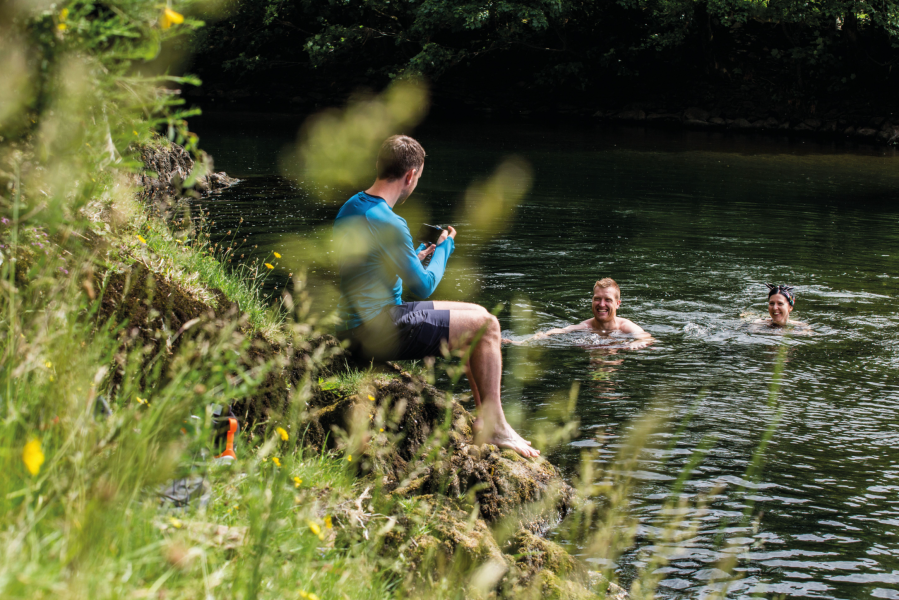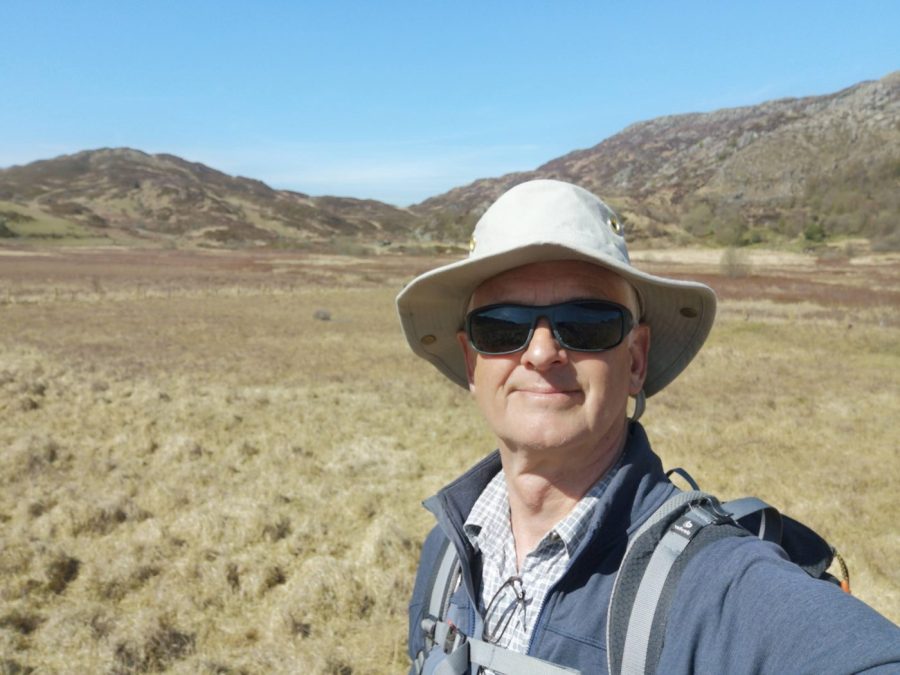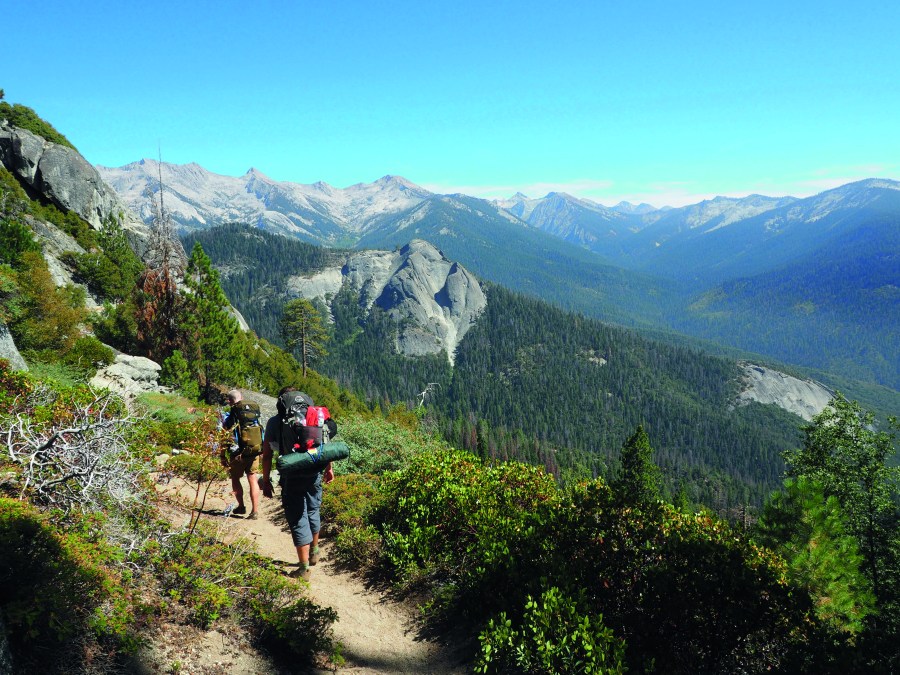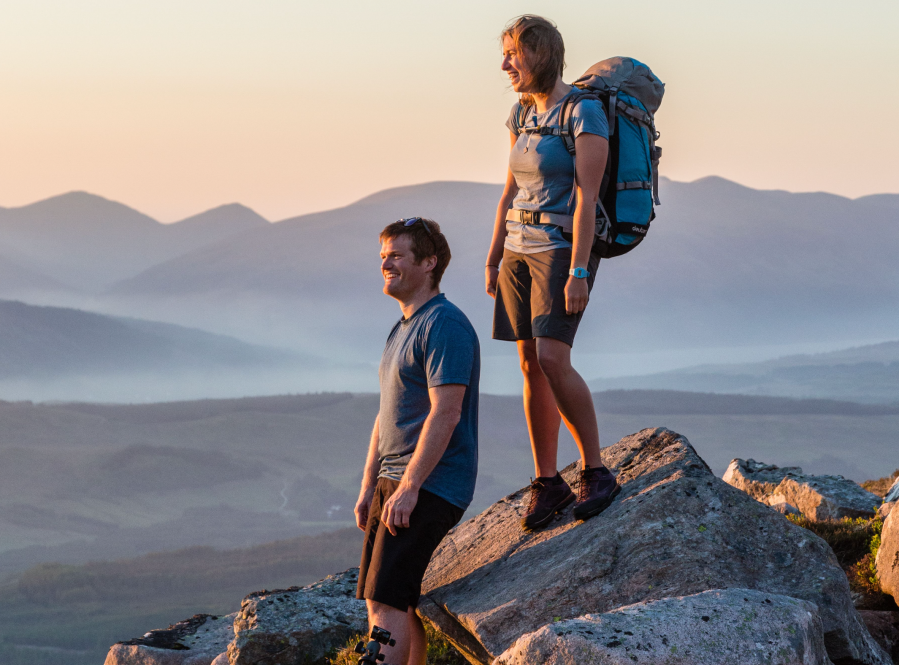How do you keep your cool and stay safe on hot days in the mountains? Here are some tips on beating the heat as a hiker.
In the summertime, when the weather is high you can stretch right up and touch the sky – or so we’ve heard. And there’s no better place to get within reaching distance of that hot ball of glowing gases than in the mountains. But you don’t want to descend from Ben More with a sunburn more befitting the beaches of Benidorm – or worse, suffer any of the other dangerous effects of heat in high places. So, with the expert input of Mike Raine (WMCI, IML and author of The Mountain Leader – a practical manual), here are some tips on how to hike in the heat.
Words: Francesca Donovan | Main image: Hikers enjoying a heatwave sunset in Scotland. Credit: Dougie Cunningham
Due to an unfamiliarity with the sun, we hillwalkers are often woefully underprepared for its appearances. Mike told The Great Outdoors that “we typically underestimate the effect of the sun”. You only need to glance into a Borrowdale beer garden at 3pm on the second Saturday of summer to know he’s not wrong.
Yes, I can already sense the murmurs of “we should be so lucky” and onslaught of reader letters cursing the “Great British weather” as I write this. But in Mike’s experience mountaineers “have had to learn to deal with drier and hotter weather in recent years” as our temperate maritime climate shifts with the impact of global warming. According to the Met Office, all of the UK’s ten warmest years on record have occurred since 2002. Indeed, it’s not long since we lamented another warm, wet winter, watching as snow melted from places it should not quicker than we could’ve imagined.
And now, here comes the sun once again. Time to root around for the wide-brimmed hat and begin bulk buying sweat-resistant suncream. But first…
Cold day in the sun
Before you reach for your map, a lifetime of weather-related disappointment has taught most of us to check the forecast first. It might be disheartening to pack for every season on a single walk, but it’s still wise to heed weather forecasts – even in the heat.
This means more than checking temperature and precipitation. Pay attention to humidity levels and UV exposure. These predict how dry the air will feel and the required level of protection to keep you safe from harmful UV rays, respectively.
It’s also worth noting what the wind will be doing on the tops, according to Mike who says a dry wind can exacerbate heat. “While a breeze might help you feel cooler, it could also dry you out,” he adds.
When it comes time to map your route, hot-weather requires further considerations. Mountainous areas rarely offer much shade due to lack of tree coverage so you should start early during the cooler parts of the day.
Plan breaks during the heat, perhaps plotting routes to shelters reachable by the hottest time of the day. Contrary to popular belief, this is not necessarily at noon when the sun is at its highest point in the sky, but rather between 2 and 3pm. The window in which to be wary, more generally, is between 11am and 3pm.

To swim or not to swim?
Credit: Jessie Leong
Furthermore, why not try diverting the usual high-level mountain traverses for a waterfall or plunge pool on route? Mike said, “For many years part of mountaineering has been going for a dip in mountain lakes. Obviously this needs to be done wisely, but at the very least soaking your feet will help you to feel better.” If you are swimming, don’t be tempted to dive right in. Submerge slowly taking deep, steady breaths and give your body time to adjust.
Multi-day backpackers must ensure their route hits plenty of potential water sources, with extra options factored in. (There’s nothing more soul-destroying than walking a mile off route in the heat of the day to a dried up source.)
A pocket full of sunshine
Once you’ve plotted your route, it’s time to pull on some warm-weather clobber and pack up your gear. Mike says, “It’s hard to stay in the shade on a mountain in the summer so full body clothing – yes, long trousers, long sleeves and a silly hat – are a must. Of course, suncream is helpful, but covering up is better.”
Let’s start from the top, shall we? “A proper sun hat with an all-round brim that covers ears and the back of the neck is important. A baseball style cap does not cut the mustard.”
Likewise, “a multifunctional neck gaiter can be invaluable and when it’s really hot. I dip mine in water often to keep me cool.” He pays particular attention to his wrists and the back of his neck. Keeping these areas cool is a great way to lower your temperature as this cools the blood which is circulating around your body. Finally, a gaiter or buff can help the (inevitable) sweat from getting in your eyes. Those who wear contact lenses will know the stinging agony to which I refer. Speaking of, you’ll also need a pair of sunglasses with UV protection to protect your eyes.

High-beating mountain fashion as modelled by Mike.
Credit: Mark Raine
Working our way down, lightweight, loose and moisture wicking clothing is preferable so you don’t get cold when you stop and your sweat dries. You can also invest in breathable base layers with UV protective qualities. It also might be time to ditch the heavy leather hiking boots for a trail runner during the summer season.
Don’t be tempted to pack less in the heat. By all means, pack lighter, but the ever-changing conditions at altitude still require you to bring layers of warm clothing in case of both weather shifts or an emergency.
Soak up the Sun
Hydration is key when hillwalking in the heat. Mike says, “Always start the day well hydrated and try to sip water as the day goes on rather than glugging large amounts all at once. Drinking bladders are very good.” Mike recommends carrying half a litre of spare water “as it’s hard to tell how much is left in your bladder and running out would be poor form”.
Running out is a common concern, especially for backpackers. When seeking water, always check above the source; “Is there human habitation? Livestock? Is the water running clear and fresh from a recognisable spring?”
Water is vital, but on hot days you’ll also need to replace lost sugars and salts. Some choose electrolyte powders or tablets – but these tend to be “a last resort”. Others simply add squash or a vitamin C tablet to their afternoon bottle of water.
Set the Controls for the Heart of the Sun
Even when prepared, the heat can still prove overwhelming as “our bodies are less well adapted to being too hot than they are to being too cold.”
Heat exhaustion is a minor if incredibly unpleasant condition caused by losing water and electrolytes. The first signs include tiredness, nausea, light-headedness and profuse sweating. If you notice these symptoms, you must rehydrate, find shade, check your body is covered appropriately, and take it easy by slowing the pace. At this stage, Mike recommends you also consider re-routing.

Backpacking in the heat of California’s Sierra Nevada. Photo: Carey Davies
Left unchecked, heat exhaustion can lead to heat stroke – a life-threatening rise in core temperature triggered by the body generating heat faster than it can cool down. Heat stroke can cause the brain to fail. This is potentially fatal in 30 minutes.
High temperatures and profuse sweating that suddenly stops are very serious warning signs, as are a rapid, strong pulse, rapid breathing and muscle cramps. Be alert for these. At first sign, evacuation off the mountain should be sought by contacting Mountain Rescue immediately.
Prevention is clearly better than cure. When it comes to staying safe on the hills in the heat, stick to Mike’s rules: “Cover up, drink and take it easy,” he advises. “Crucially, be prepared to change your route. The mountain will still be there next week. Make sure you are.”








